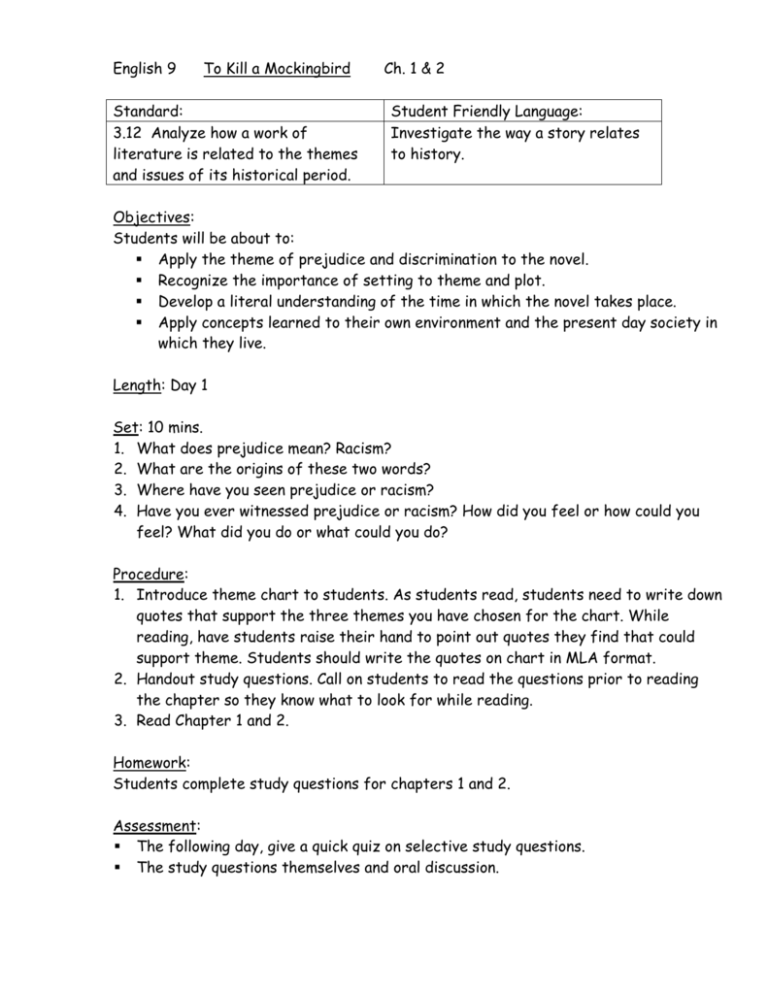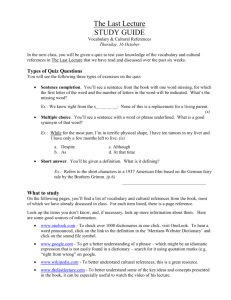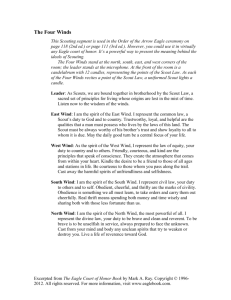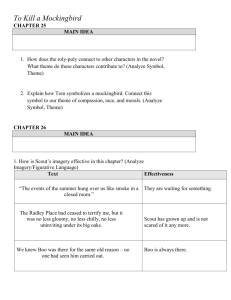TKM Lesson Ch 1-6
advertisement

English 9 To Kill a Mockingbird Standard: 3.12 Analyze how a work of literature is related to the themes and issues of its historical period. Ch. 1 & 2 Student Friendly Language: Investigate the way a story relates to history. Objectives: Students will be about to: Apply the theme of prejudice and discrimination to the novel. Recognize the importance of setting to theme and plot. Develop a literal understanding of the time in which the novel takes place. Apply concepts learned to their own environment and the present day society in which they live. Length: Day 1 Set: 10 mins. 1. What does prejudice mean? Racism? 2. What are the origins of these two words? 3. Where have you seen prejudice or racism? 4. Have you ever witnessed prejudice or racism? How did you feel or how could you feel? What did you do or what could you do? Procedure: 1. Introduce theme chart to students. As students read, students need to write down quotes that support the three themes you have chosen for the chart. While reading, have students raise their hand to point out quotes they find that could support theme. Students should write the quotes on chart in MLA format. 2. Handout study questions. Call on students to read the questions prior to reading the chapter so they know what to look for while reading. 3. Read Chapter 1 and 2. Homework: Students complete study questions for chapters 1 and 2. Assessment: The following day, give a quick quiz on selective study questions. The study questions themselves and oral discussion. English 9 To Kill a Mockingbird Ch. 1 & 2 continue Standards: Student Friendly Language: 3.3. Analyze interactions between main and subordinate characters in a literary text and explain the way those interactions affect the plot. 3.4. Determine characters’ traits by what the characters say about themselves in narration, dialogue, dramatic monologue, and soliloquy. 3.6. Analyze and trace an author’s development of time and sequence, including the use of complex literary devices. Study characters and how their relationships affect the story. Describe characters’ personalities using clues (i.e. quotes) from the story. Know the time and order of events of a story. Objectives: Students will be about to: Describe the setting and the attitudes that develop as a result of the setting. Develop Scout’s character Relate their personal experiences during the first and second grade to Scout’s. Understand the importance of setting to a novel. Length: Day 2 Set: 10 mins. Childhood Memories: What do you remember about the first and second grade? Did you like school? What types of games did you enjoy? Did you ever get in trouble? What adults did you like? Dislike? Fear? What did you think of your parents? Procedure: 1. Quiz on readings/study questions from yesterday. 2. Have students describe the atmosphere of the story while using quotes to support. 3. Discuss study questions for chapters 1 and 2 and any questions students have about the story. 4. Begin character log on Scout. Students create a chart with the following topics: physical description, adjectives of personality, character says, character does/behavior, what others say about character, and character’s opinions. Beyond: Map the setting. Homework: Students find two examples of pride and two examples of mistrust in the story. Students have quotes to support and must describe how pride and mistrust are connected to Scout’s character. Assessment: Oral participation with character log of Scout and homework. English 9 To Kill a Mockingbird Ch. 3 & 4 Standards: Student Friendly Language: 3.3 Analyze interactions between main and subordinate characters in a literary text and explain the way those interactions affect the plot. 3.4 Determine characters’ traits by what the characters say about themselves in narration, dialogue, dramatic monologue, and soliloquy. 3.6. Analyze and trace an author’s development of time and sequence, including the use of complex literary devices. Study characters and how their relationships affect the story. Describe characters’ personalities using clues (i.e. quotes) from the story. Know the time and order of events of a story. Objectives: Students will be about to: Explain the differences between Jem and Scout, Burris Ewell and the other children and provide examples from the text. Understand the thematic significance of Atticus’ advice to Scout. Describe Scout’s relationship with other students. Length: Day 3 Set: 10 mins. Describe a bad experience you had in school and while it was embarrassing or humiliating. Procedure: 1. Read chapters 3 and 4. Students fill out theme chart while reading. 2. Have students describe Scout’s classroom and her relationship with various students. Have students describe Scout’s attitude towards Walter Cunningham. Have students generalize Scout’s perspectives of other people. Ask students Scout’s perspectives connect to the theme of prejudice or racism. Have students make a prediction on if and how Scout will change her perspectives in the future. 3. Discuss Atticus’ compromise with Scout and what he is asking her to do. 4. Have students add to character log. Closure: Have students interpret and comment on the following quote and collect: Ch. 3 “You never really understand a person until you consider things from his point of view” (30). Homework: Students complete study questions for chapters 3 and 4. Assessment: Interpretations of quote. The following day, give a quick quiz on selective study questions. The study questions themselves and oral discussion. English 9 To Kill a Mockingbird Ch. 5 & 6 Standards: Student Friendly Language: 3.3 Analyze interactions between main and subordinate characters in a literary text and explain the way those interactions affect the plot. 3.4 Determine characters’ traits by what the characters say about themselves in narration, dialogue, dramatic monologue, and soliloquy. 3.6. Analyze and trace an author’s development of time and sequence, including the use of complex literary devices. Study characters and how their relationships affect the story. Describe characters’ personalities using clues (i.e. quotes) from the story. Know the time and order of events of a story. Objectives: Students will be about to: Understand the significance of the town’s conclusion regarding the disturbances at the Radley place. Length: Day 4 Set: 10 mins. Quiz on chapter 3 and 4 study questions. Procedure: 1. Discuss chapters 3 and 4 study questions. 2. Read chapters 5 and 6. Students fill out theme chart while reading. 3. Discuss the Radleys and the connection to prejudice or racism. Discuss what is the mystery behind the Radleys that intrigues the kids. 4. Discuss Miss Maudie’s function in the story and connect to prejudice or racism. 5. Students add new characters to character log and continue to add to Scout’s. Closure: Have students interpret and comment on the following quote and collect: Ch. 6 “It was then, I suppose, that Jem and I first began to part company” (56). Homework: Students complete study questions for chapters 5 and 6. Assessment: Interpretations of quote. The following day, give a quick quiz on selective study questions. The study questions themselves and oral discussion.







